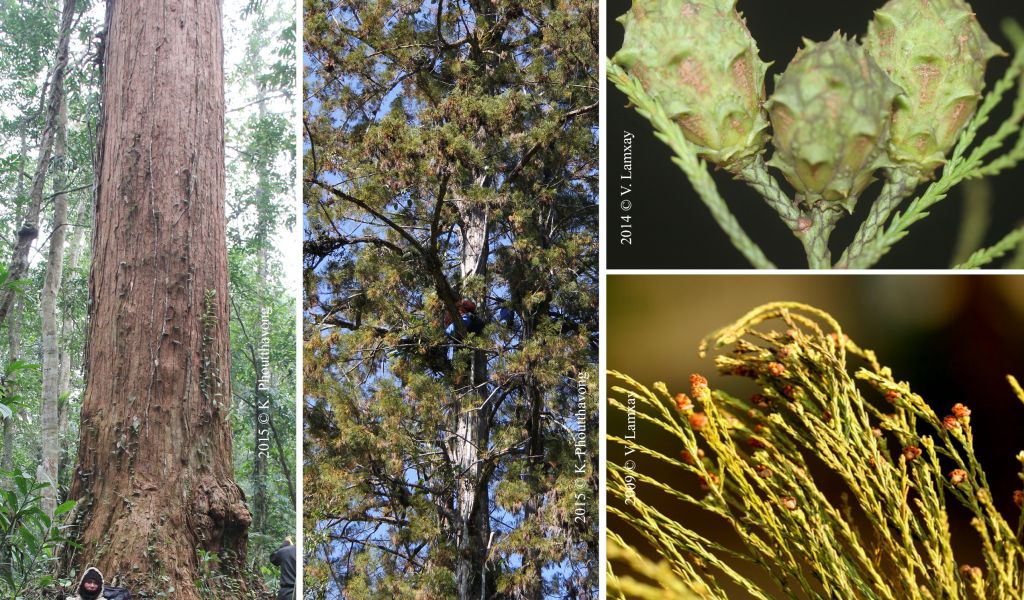ເລກລຳດັບທີ: 546
ລະດັບການຮວບຮວມຂໍ້ມູນ: ຂໍ້ມູນພື້ນຖານ
ປັບປູງຄັ້ງລ່າສຸດ: N/A
ໄມ້ຫີ້ງທາມ
Swamp Cypress
Glyptostrobus pensilis (Staunton ex D.Don) K.Koch
ພືດ
ໄມ້ຢືນຕົ້ນ
ຕົ້ນໄມ້ ແລະ ປາມ
×
ຊື່ທ້ອງຖີ່ນ:
Chinese swamp cypressChinese Water FirChinese water-pine ( Chinese swamp cypressChinese Water FirChinese water-pine)
ຊື່ພ້ອງ
:
Cuprespinnata heterophylla (Brongn.) J. Nelson
Cuprespinnata sinensis (J. Forbes) J. Nelson
Cupressepinnata heterophylla (Brongn.) J.Nelson
Cupressepinnata sinensis (J.Forbes) J.Nelson
Cupressus nucifera Carrière
Glyptostrobus aquaticus (Roxb.) R.Parker
Glyptostrobus heterophyllus (Brongn.) Endl.
Glyptostrobus sinensis A.Henry ex Loder
Juniperus aquatica Roxb.
Sabina aquatica (Roxb.) Antoine
Schubertia nucifera Denham ex Endl.
Taxodium heterophyllum Brongn.
Taxodium japonicum Dehnh. ex Gordon
Taxodium japonicum var. heterophyllum Brongn.
Taxodium sinense J.Forbes
Thuja lavandulifolia Poir.
Thuja pensilis Abel
Thuja pensilis Staunton ex D.Don
Cuprespinnata sinensis (J. Forbes) J. Nelson
Cupressepinnata heterophylla (Brongn.) J.Nelson
Cupressepinnata sinensis (J.Forbes) J.Nelson
Cupressus nucifera Carrière
Glyptostrobus aquaticus (Roxb.) R.Parker
Glyptostrobus heterophyllus (Brongn.) Endl.
Glyptostrobus sinensis A.Henry ex Loder
Juniperus aquatica Roxb.
Sabina aquatica (Roxb.) Antoine
Schubertia nucifera Denham ex Endl.
Taxodium heterophyllum Brongn.
Taxodium japonicum Dehnh. ex Gordon
Taxodium japonicum var. heterophyllum Brongn.
Taxodium sinense J.Forbes
Thuja lavandulifolia Poir.
Thuja pensilis Abel
Thuja pensilis Staunton ex D.Don
ຊື່ສະກຸນ:
Cupressaceae
ຊະນິດໃກ້ຄຽງ:
ບັນຍາຍລັກສະນະທາງພືດສາດ:
ນິເວດວິທະຍາ
ເຂດກະຈາຍພັນທົ່ວໂລກ:
N/A
ເຂດກະຈາຍພັນໃນລາວ
:
ເຂດສາຍພູຫຼວງພາກເໜືອ

ເຂດກະຈາຍພັນຕາມພູມສັນຖານ
:
ສະເພາະຖິ່ນໃນລາວ:
N/A
ຮຸກຮານ
:
N/A
ສະຖານະພາບການອະນູຮັກ IUCN
:
ໃກ້ສູນພັນສູງສຸດ
ສະຖານະພາບການອະນຸຮັກແຫ່ງຊາດລາວ
:
N/A
ການນຳໃຊ້
ປະເພດການນຳໃຊ້:
ກິດຈະກໍາເພື່ອຄວາມລື່ນເລີງ
ສິ່ງປູກສ້າງ
ສິ່ງປູກສ້າງ
ບັນຍາຍການນຳໃຊ້:
ເປັນໄມ້ເນື້ອລະອຽດອ່ອນ ແລະ ມີຄວາມສວຍງາມ, ແຕ່ມີຄວາມທົນທານຕໍ່ສະພາບແວດລ້ອມໄດ້ດີ. ພົບວ່ານິຍົມການນຳໃຊ້ໄມ້ຊະນິດ ນີ້ໃນປະເທດຈີນ ເພື່ອເຮັດເປັນເຟີນິເຈີ ແລະ ເປັນໜອນຂົ້ວ ຫຼື ລ່າງລົດໄຟ. ເນື້ອໄມ້ຈາກຮາກມີຄວາມເບົາ ແລະ ອ່ອນສາມາດເຮັດ ເປັນເຄື່ອງສຸຊິບໄດ້. ໄມ້ຊະນີດນີ້ໃນ ປະເທດໄດ້ມີການປູກຢ່າງກວ້າງຂວາງໃນພາກໃຕ້ ໂດຍປູກຕາມແຄມແມ່ນ້ຳ ຫຼື ຄອງໃນສວນສາທາລະນະ. ແຕ່ໃນທຳມະຊາດໄດ້ມີການຕັດເພື່ອນຳໃຊ້ ແລະ ປູກທົດແທນຄືນໃໝ່. ໃນຫວຽດນາມເປັນໄມ້ມີມູນຄ່າສູງ ເຊື່ອກັນວ່າ ໄມ້ຊະນິດມີສາມາດຕ້ານເຊື້ອມະເຮັງໄດ້ ເຖີງແມ້ຈະບໍ່ມີຫຼັກຖານ ທາງດ້ານວິທະຍາສາດ. ສ່ວນຢູ່ລາວ ໄດ້ມີ ການລັກລອບຕັດ ເພື່ອສົ່ງອອກຫວຽດນາມ, ແລະ ມີການນຳໃຊ້ປູກສ້າງເຮືອນຊານ. ( Thomas et al. 2011)
ການປູກ ການລ້ຽງ:
N/A
ລະດູການເກັບກູ້:
ການຕະຫຼາດ ແລະ ຕ່ອງໂສ້ມູນຄ່າ:
N/A
ການຄຸ້ມຄອງຈັດການ
N/A
ໂພຊະນາການ
ຄຸນຄ່າທາງໂພຊະນາການ:
ບັນຍາຍຄຸນຄ່າທາງໂພຊະນາການ:
N/A
| ສານອາຫານ | /100g | ໝາຍເຫດ |
|---|---|---|
| ໂປຣຕີນ | N/A | N/A |
| ຄາໂບໄຮເດຣດ | N/A | N/A |
| ໄຂມັນ | N/A | N/A |
| ວິຕາມິນ | N/A | N/A |
| ແຮ່ທາດ | N/A | N/A |
| ເສັ້ນໄຍ | N/A | N/A |
ອ້າງອິງ
ເຄດິດຮູບພາບ:
ອ້າງອິງ:
Farjon A. 2005. A monograph of the Cupressaceae and Sciadopityaceae. Royal Botanic Gardens Kew, Richmond, UK.
Leonid V. Averyanov, Tien Hiep Nguyen, Khang Nguyen Sinh, The Van Pham, Vichith Lamxay, Somchanh Bounphanmy, Shengvilai Lorphengsy, Loc Ke Phan, Soulivanh Lanorsavanh, Khamfa Chantthavongsa. 2014. Gymnosperms of Laos. Nordic Journal of Botany 32(6): 765-805
Nguyen Duc To Luu & P. Thomas. 2004. Cay La Kim Viet Nam (Conifers of Vietnam: an illustrated field guide).
Nguyen Tien Hiep, Phan Ke Loc, Nguyen Duc To Luu, P.I. Thomas, A. Farjon, L. Averyanov & J. Regalado Jr. 2004. Vietnam Conifers: Conservation Status Review 2004. Fauna & Flora International, Vietnam Programme, Hanoi.
Publishing House, Hanoi. 121 pp. (in Vietnamese and English).
Thomas, P., Yang, Y., Farjon, A., Nguyen, D. & Liao, W. 2011. Glyptostrobus pensilis. The IUCN Red List of Threatened Species 2011: e.T32312A9695181. http://dx.doi.org/10.2305/IUCN.UK.2011-2.RLTS.T32312A9695181.en.
Leonid V. Averyanov, Tien Hiep Nguyen, Khang Nguyen Sinh, The Van Pham, Vichith Lamxay, Somchanh Bounphanmy, Shengvilai Lorphengsy, Loc Ke Phan, Soulivanh Lanorsavanh, Khamfa Chantthavongsa. 2014. Gymnosperms of Laos. Nordic Journal of Botany 32(6): 765-805
Nguyen Duc To Luu & P. Thomas. 2004. Cay La Kim Viet Nam (Conifers of Vietnam: an illustrated field guide).
Nguyen Tien Hiep, Phan Ke Loc, Nguyen Duc To Luu, P.I. Thomas, A. Farjon, L. Averyanov & J. Regalado Jr. 2004. Vietnam Conifers: Conservation Status Review 2004. Fauna & Flora International, Vietnam Programme, Hanoi.
Publishing House, Hanoi. 121 pp. (in Vietnamese and English).
Thomas, P., Yang, Y., Farjon, A., Nguyen, D. & Liao, W. 2011. Glyptostrobus pensilis. The IUCN Red List of Threatened Species 2011: e.T32312A9695181. http://dx.doi.org/10.2305/IUCN.UK.2011-2.RLTS.T32312A9695181.en.
ຜູ້ສ້າງ Factsheet:
ຜູ້ກວດສອບ Factsheet:
,
